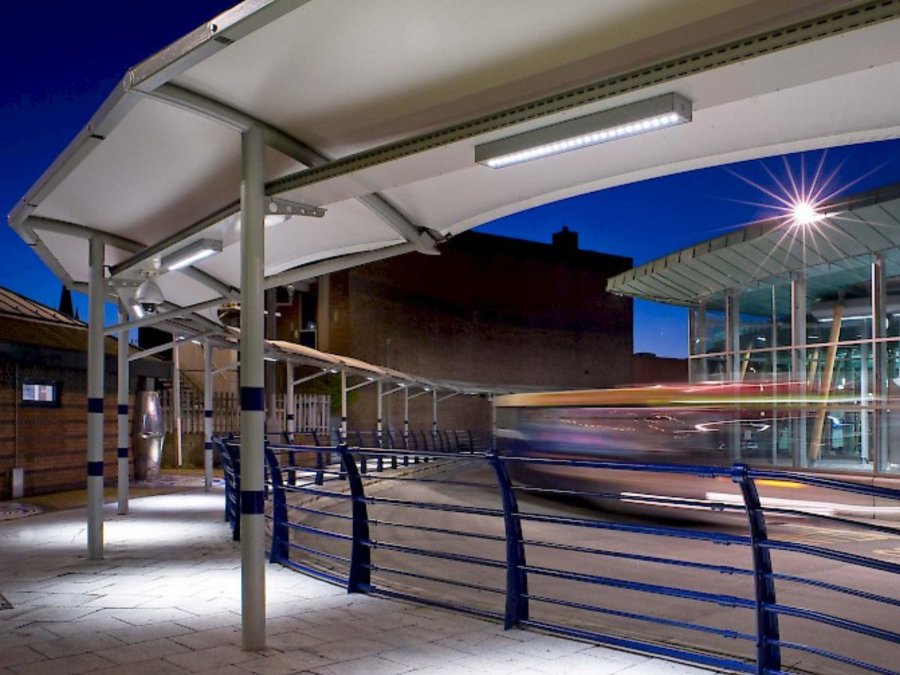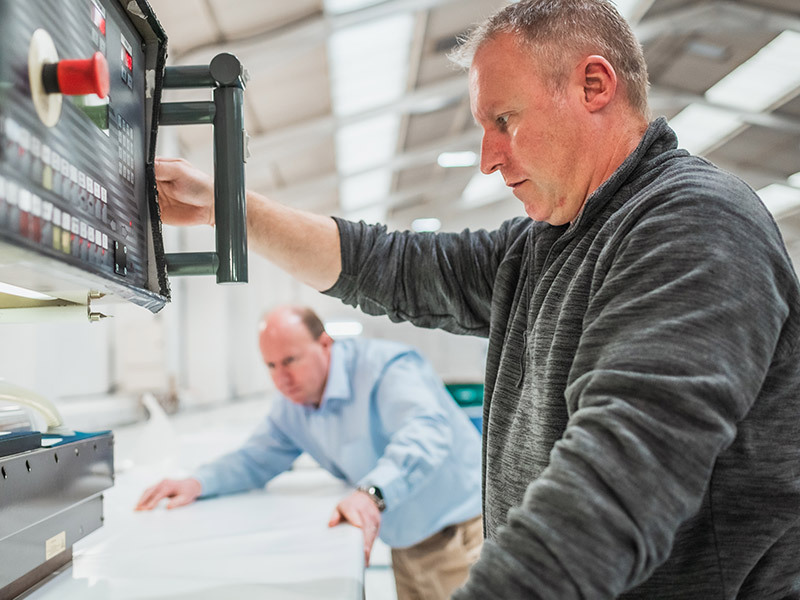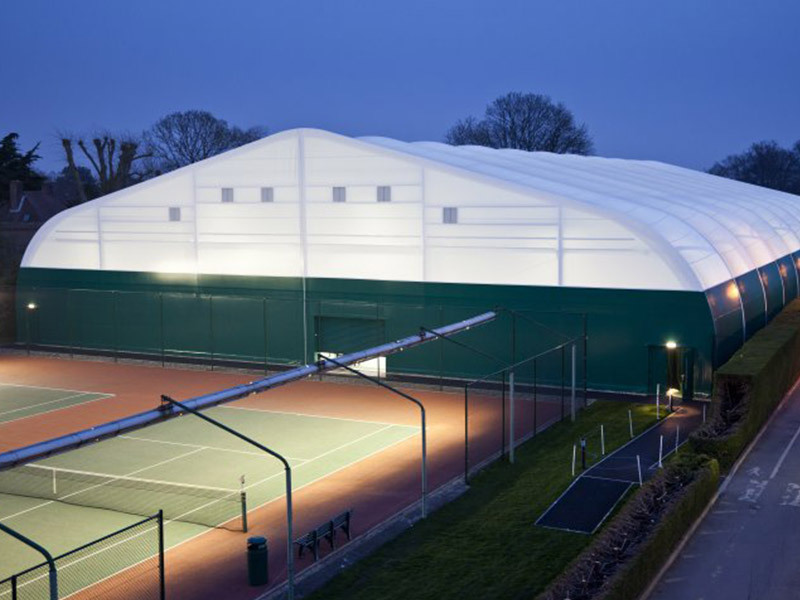
Lighting Tensile Fabric Structures for Darker Days
As the clocks change and evenings draw in, we use light to bring out the best in a tensile canopy. Unlike solid roofs, a membrane transmits and scatters light, so the structure itself can glow, guide and welcome. PVC-coated polyester and PTFE-coated glass fabric provide a soft, even diffusion that’s ideal for public spaces, while ETFE cushions allow more daylight to pass through, helping to reduce daytime energy consumption and delivering a calm, consistent look after dark. When colour temperature matches the setting, crisper whites for retail walkways and stadium concourses, warmer whites for hospitality pockets and campus routes, the tensile membrane does the rest, turning practical cover into a place people want to be.

Let The Membrane Lead
We start by designing around the fabric. Our aim is to light the membrane, not fight it. A gentle perimeter wash creates uniform brightness without hot spots. We then add task lighting only where it’s genuinely needed for ticketing, seating, circulation or signage. Clients sometimes worry that LEDs might harm the fabric; they won’t when we detail them correctly. On lightweight tensile structures, we specify low-profile, low-heat luminaires and hold safe clearances to protect the surface. We manage heat by locating drivers remotely in ventilated positions and we choose housings and fixings that won’t abrade or discolour the architectural fabric through seasonal movement.
Because the canopy is a working piece of engineering, lighting layouts also respect patterning, seams and load paths. We typically mount to perimeter beams, masts or secondary steel; where a membrane penetration is unavoidable, we use purpose-made collars and test for watertightness. Before anything goes up, we validate the scheme with photometric modelling so you can see uniformity, average illuminance and glare performance in context. The result is a night-time effect that feels intentional and legible, not bolted on.
Our approach mirrors what we set out in our own guidance on night-time fabric architecture: tensile structures are flexible, sustainable and engineered to work in harmony with lighting, which is why they make such strong after-dark landmarks.
Integrate Lighting and Controls with The Structure
Great after-dark spaces look effortless because the engineering is doing the heavy lifting. We coordinate structure, membrane and MEP from the outset so lighting works with seams and support steel rather than fighting them. Controls are kept simple to run and simple to maintain. Daylight sensors trim output when ambient levels are high. Presence detection brings areas up only when people are around. Scene presets handle late-opening retail, match-day peaks and low-spill overnight modes for neighbours. Where useful, we link into your BMS via DALI or DMX so facilities teams can manage everything in one place.
We often collaborate with specialist lighting partners to deliver creative effects, while we focus on the membrane and structure. That split plays to everyone’s strengths and is exactly how our best-known illuminated projects operate at night.
You can see this approach on the Hilton Garden Inn, Silverstone, where our tensile canopy on the rooftop terrace creates a distinctive profile by day and a confident silhouette by night. The scheme combines our high-tensile PVC membrane and steel with external lighting specialists’ systems, so race-day hospitality looks striking without compromising programme, maintenance or safety.
Make It Maintainable, Safe and Sustainable
A lighting scheme is only as good as your ability to look after it. We design safe reach from day one, fixed access points, walkable routes or winch-down fittings, so your team never has to touch the tensile membrane during routine work. Clear zoning and local isolation reduce downtime and remote drivers make replacements quick. Smooth-bodied housings and sensible IP ratings keep dirt build-up under control, which means cleaning takes minutes, not hours.
Public spaces also demand robust detailing and documentation. We check additional point loads and vibration for suspended fittings on the support steel, specify appropriate IP ratings and corrosion resistance, integrate compliant emergency levels without glare and record any penetrations so the as built matches the drawings. Thoughtful optics and cut-off control obtrusive light to protect neighbours, important across retail parks, stadium edges and university campuses.
Sustainability runs through the entire approach. The membrane’s translucency reduces daytime demand and enables lower light levels at night for the same perceived brightness. On our night-time projects, we pair efficient materials and structure-first detailing with energy-saving lighting designed by partners, so visual impact doesn’t come at the expense of sensible consumption. That philosophy is central to how we talk about lighting in our night-time article and across our recent news.
Where This Adds Value (With Real-World Proof)
Retail parks
Warm, even canopy light improves wayfinding and makes covered walkways feel comfortable after dusk, while discreet feature moments at entrances support brand visibility. Our Malls, Basingstoke entrance canopy shows how precise patterning and set out deliver a crisp finish that reads clearly by night as well as by day.
Stadium concourses
Consistent, low-glare light keeps ticketing and security running smoothly, then pre-set scenes handle build-up, half-time and egress without drama. At Beacon of Light in Sunderland, our 4,000 m² tensile roof demonstrates how a large membrane surface can become a community marker after dark with the right integration of lighting and structure. We maintain the asset to keep performance high year after year.
Hospitality and venues
At Hilton Garden Inn, Silverstone, our cantilevered barrel-vault wings cover up to 200 guests with a high-tensile PVC membrane. The lighting systems, provided by external specialists, sit comfortably with the structure, so the terrace reads as an architectural feature on race days and throughout the season.
Civic markers
Landmark sails such as Portsmouth Tri-Sail show how a slender membrane and mast can hold presence on a skyline. When illuminated, the form becomes a clear coastal marker without heavy infrastructure.
Why choose J&J Carter for Night-Time Tensile Fabric Projects
We’re the partner you choose when the brief is about impact after dark and reliability all year. Our edge is delivery, not just design: one accountable team plans the sequence, fabricates off site and installs with minimal disruption to live venues. We manage approvals with the paperwork authorities expect, light-spill modelling, method statements, O&M packs so sign-off is smoother.
You get visual certainty before we break ground. We develop night renders and performance studies that show how the structure will read from key approaches, how routes will feel and where brand moments land. During construction we keep sites moving with phased works, safe segregation and night shifts to avoid trading hours where required.
We design for the whole life of the asset. That means clear access for upkeep, simple swap-outs for drivers and fittings and a defined pathway for future upgrades or re-skins without replacing the steel. At handover we provide training for facilities teams, a spares kit where appropriate and a maintenance plan that protects appearance and uptime through winter. Contact J&J Carter today to discuss your requirements and explore how our lighting for tensile fabric structures keeps spaces safe, welcoming and efficient on darker days.


